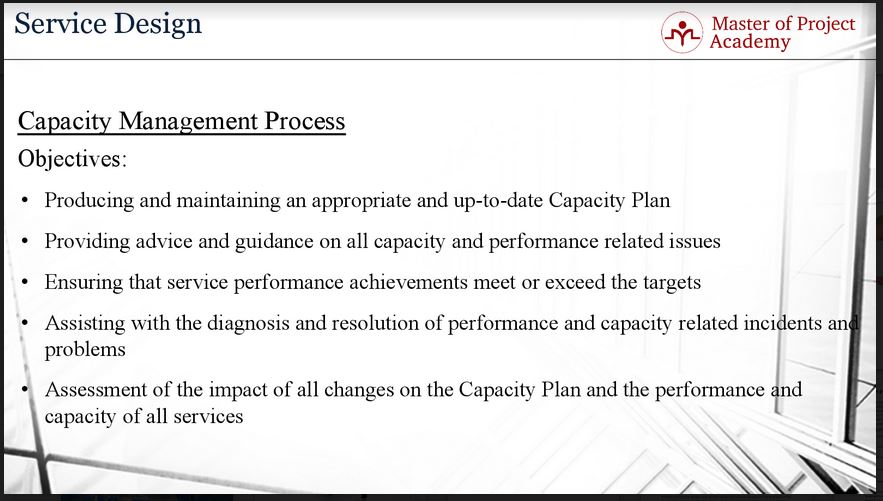The dictionary definition of capacity is the ability to receive or contain. Or more specifically, the maximum amount or number of things that can be received or contained. From an ITIL foundation training point of view, capacity has a similar meaning as well. Capacity in IT service level management defines the upper limits of a service that can be served for the users. The maximum number of users that can use a service and maximum concurrent users that can use a service without service degradation draws the boundary of the capacity for regarding service. Capacity management as part of the ITIL Service Design processes is covered in depth in online ITIL courses. In order to successfully apply capacity management, it is important to understand the underlying goals and objectives of the capacity management process.
What Are Its Goals?
The main goal of the capacity management process is ensuring cost-justifiable IT capacity in all areas of IT and also that it is matched to the current and future agreed needs of the business. The main goal of a service provider is ensuring that the business requirements are realized as services to the customers. While doing this, cost-justification must be done as well.
For instance, if the business requirement needs to reflect that a service must support 100 000 users and if there are only 50 000 customers of the company for the moment, this will be a meaningless request from the business side. The business must first build their customer base to a larger user base in order for the larger capacity requirements to be justified.
Or, if business needs require that 100 000 users must be supported with the provided service, and if this requirement brings a higher cost to IT side than the revenue that will be expected from this service. So, it won’t be a sustainable business for the company.
Conversely, if the business requirements match the requested IT capacity, the IT capacity manager can approve the use of the required capacity as it will add value to the business without incurring too much cost. Therefore, while ensuring the capacity requirements of the business, the capacity management process always check whether the required capacity is cost justifiable.
The objectives of the capacity management process
One of the first objectives of the capacity management process is to produce and maintain an appropriate and up-to- date capacity plan which reflects the current and future needs of the business. For instance, let’s imagine that the business requirement of a telecom operator is that instant match scores must be provided as an SMS service to its subscribers. If the capacity requirement for this service is serving up to 100 000 users and 500 customers concurrently, then a capacity plan has to be prepared by the IT service provider in the scope of the capacity management process. The capacity plan must detail how many servers will be needed, how many support personnel will be working etc. Capacity management needs to take place to compile a sufficient and accurate capacity plan that will support the service.

The second objective of capacity management is to provide advice and guidance on all capacity and performance related issues. Let’s look at an example of how this works in terms of capacity management. For instance, imagine that the required capacity of a service was serving up to 100 000 users at maximum. During operation, if it has been seen that service degradations started after 80 000 users, the root cause of this performance and capacity issue need to be identified and addressed. This is within the scope of the capacity management process. IT service owners rely heavily on the advice and guidance received during the capacity management process to determine the root cause underlying a capacity problem.
Ensuring that the service performance achievements meet or exceed their targets is also another objective. An IT service provider has to meet the business requirements of the customer. And these requirements also include capacity requirements as well. If the service level targets are not met, the capacity management process must be followed to ensure that there is sufficient capacity to meet or exceed service level targets.

Another objective is assisting with the diagnosis and resolution of performance and capacity related incidents and problems. If an IT service provider does not meet the capacity requirements for a service, the reason for not meeting the requirements have to be analyzed. During these analysis and diagnosis, this process aims to highlight the root cause of the problems and incidents. The root cause that has been identified through the capacity management process will help to improve the service so that it can reach its service level targets.
The final objective is the assessment of the impact of all changes on the capacity plan and the performance and capacity of all services. Consider a service that is provided by four servers, two support personnel and two databases. Now imagine that there is a change or upgrade to one of these servers or databases, or that one of the support personnel has quit his job. The impact of these changes on the capacity of the services need to be analyzed and this is done whithin the scope of the capacity management process.
This is a key process within the ITIL Service Design stage of the ITIL lifecycle. The root cause analysis that forms part of the capacity management process also links the process to the Continual Service Improvement stage of the ITIL service lifecycle. Through effective capacity management, there will always be sufficient capacity available to keep services running at their service level targets.
Review by: Stephanie Morris


One thought on “Capacity Management: How Does it Fit into ITIL Service Design?”
Comments are closed.